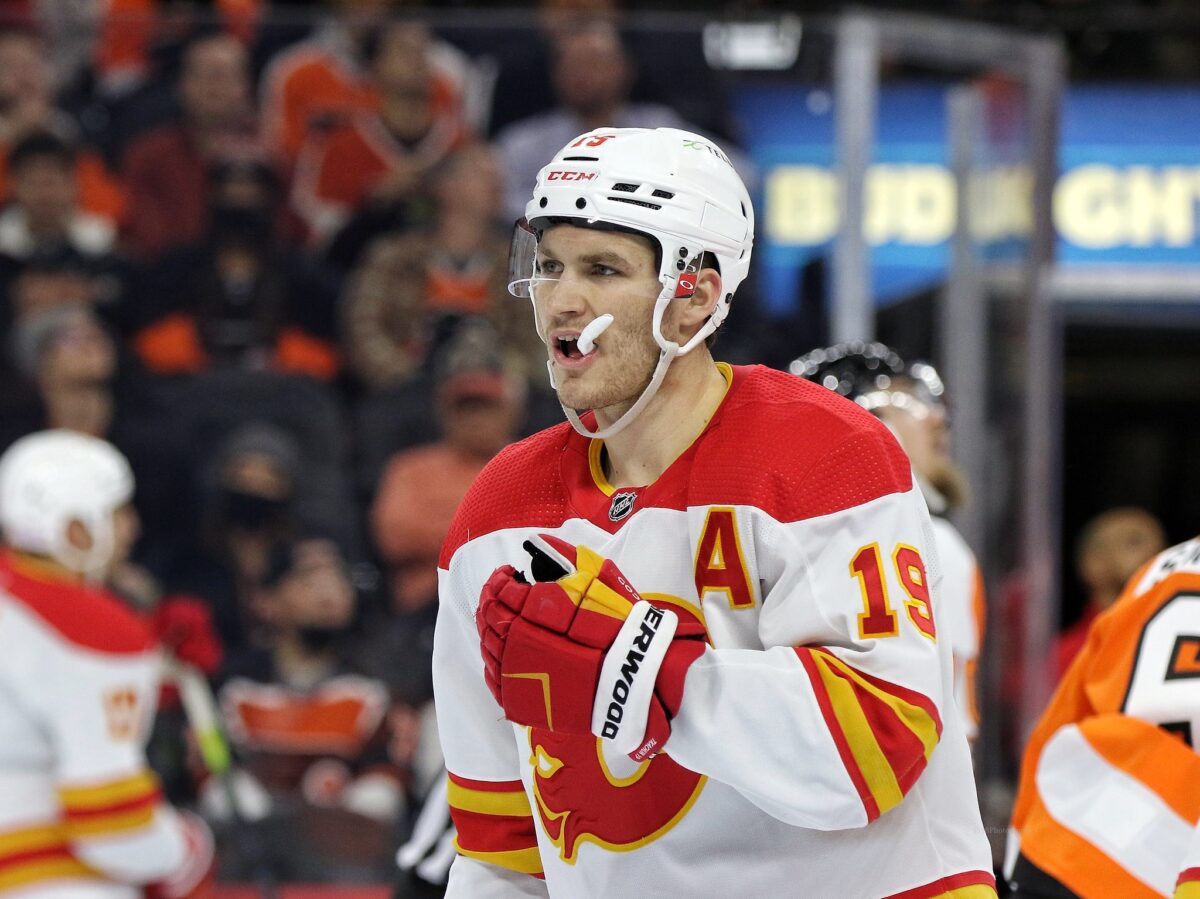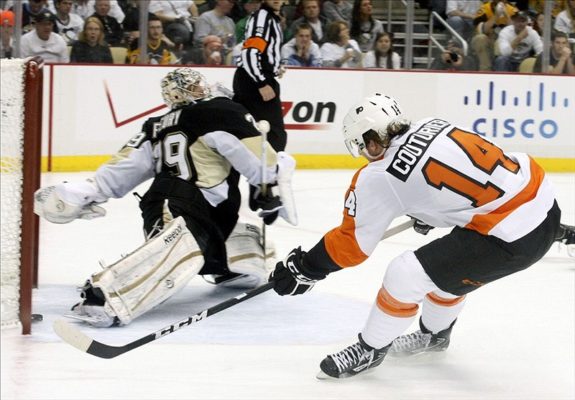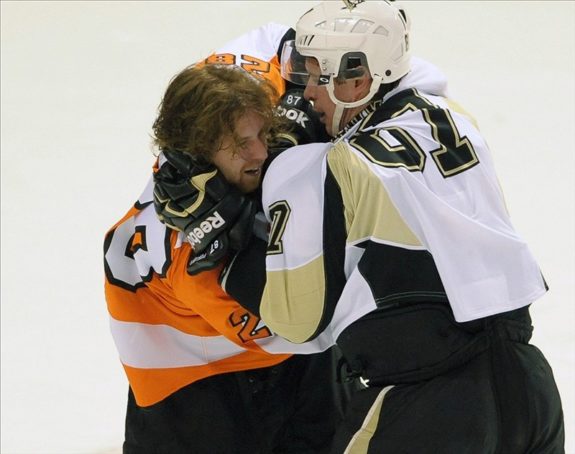The Edmonton Oilers took a 2-1 lead in the Western Conference Semifinal with an emphatic 4-1 victory over the Calgary Flames on the back of an Evander Kane hat trick on Sunday night. The Battle of Alberta has been filled with prolific offense, high emotion in the crowd and on the ice, bad blood boiling to the surface, and overall incredibly entertaining hockey for the first three games of the series.
Intense geographic rivalries can naturally produce drama and a chaotic style of quickly alternating momentum that drives intriguing storylines. The Philadelphia Flyers and the Pittsburgh Penguins faced off in the opening round of the 2012 Stanley Cup Playoffs in one of the most unpredictable and chaotic playoff series in the history of the NHL. The dramatic slugfest set a precursor for the Battle of Alberta in 2022.
Offensive Explosions in Pennsylvania, Alberta
The NHL thrives off of intensity when rival teams meet during the postseason. The individual feud between Zack Kassian and Matthew Tkachuk in recent seasons has helped reignite the Battle of Alberta to regain its position as one of the best rivalries in the NHL. The temporary realignment of the NHL divisions in 2020-21 helped further grow the intensity between all Canadian teams and fan bases. Until last week, the two neighboring franchises had gone 31 years without meeting in the playoffs, but their respective climbs back into contention now have the rivalry on center stage.

The high level of energy from the two rabid fan bases, the familiarity between opponents, and the history of tension between the two franchises make for excellent entertainment and great storylines for the NHL. The Flyers and the Penguins met in the playoffs for the third time in five years in 2012. The bitterness between the Pennsylvanian arch-rivals spilled over in late-season matchups in April 2012, but nobody could’ve envisioned the circus that would take place in the Eastern Conference Quarterfinal.
The Penguins jumped out to a commanding 3-0 lead on home ice in the first period of Game 1, only to let the Flyers crawl back and steal the series lead with a 4-3 overtime victory on a game-winner by Jakub Voracek. Game 2 somehow became more eventful than the stunning comeback. Claude Giroux and Sean Couturier led an offensive explosion that erased an early 2-0 Penguins lead. The two centers each scored hat tricks and put the Flyers on top 2-0 in the series heading back to Philadelphia.
Related: Reliving the Flyers & Penguins 2012 Playoff Series
The Oilers have similarly survived early deficits to take the lead in the series. They rallied from a 6-2 deficit in Game 1 with four consecutive goals on Vezina finalist Jacob Markström. Although they couldn’t finish off the comeback, they have been able to use the chaos of constantly changing momentum to their advantage. They rallied from a two-goal deficit to steal Game 2 in Calgary. After moving past the highest-scoring playoff game in 29 years and the emotions of the series-opener, Edmonton has settled into their preferred style in Games 2 and 3. They now own a 2-1 advantage with Game 4 looming on their home ice.
Goaltenders Struggle with Environment, Emotions
While the offensive onslaughts entertain the fans, the goalies don’t exactly enjoy the style. Markström has allowed 15 goals in three starts after finishing the 2021-22 regular season with a 2.22 goals against average (GAA). Mike Smith lasted just six minutes in Game 1. He also had to leave Game 3 temporarily for precautionary concerns about a potential concussion. He has rebounded well after the early disaster with two victories, including an excellent effort in Game 3 when he stopped 32 of 33 Calgary shots on goal.

The Penguins and Flyers combined for 56 goals in their 2012 series, tied for the fourth-highest total in a six-game series in NHL history. Future Hall of Famer Marc-Andre Fleury finished the series with an .834 save percentage (SV%), while his opponent Ilya Bryzgalov only slightly outdid him with an .871 mark. Neither goalie survived the offensive circus to finish all six games.
The infamous and seemingly perennial struggles of Flyers goaltenders rose in Game 4 when the Penguins relieved frustration from an 0-3 series deficit with a 10-3 victory. Jordan Staal became the third player in the series to notch a hat trick, and Sidney Crosby and Evgeni Malkin recorded three points apiece. Bryzgalov took a seat after allowing five goals on 18 shots in just over 23 minutes of action. Future star Sergei Bobrovsky matched the cringe-worthy stat line by allowing another five goals on 18 shots in relief.
Rough Stuff Between Rivals
The emotions spilled over between the Flyers and the Penguins in Game 3. James Neal threw a vicious blindside check on Couturier in the third period and later targeted Giroux with the game out of reach. Crosby immaturely smacked Voracek’s glove away when the Flyers winger bent to pick it up after a scrum begun by the Penguins captain. Wayne Simmonds chased down Neal during a stoppage late in the third period to continue the fisticuffs. Scott Hartnell and Craig Adams dropped the gloves immediately afterward.
The game ended with six misconducts, four fighting majors, one match penalty, and 158 total penalty minutes. The Flyers won 8-4, and three Penguins received suspensions for their actions during the game.

The Flames and the Oilers haven’t mixed it up quite as much, at least not yet. However, that might change after a charging major and misconduct were assessed to Milan Lucic late in a Game 3 when the outcome was essentially decided. Flames head coach Darryl Sutter showed no fear of retribution during his postgame availability.
The Penguins lost their composure against a team with inferior talent in 2012 and ended up with a first-round exit when they had Stanley Cup aspirations. The Flyers didn’t control their emotions at all points during the series either. The Oilers and the Flames will need to balance their intensity and save their aggression for the right situations for the rest of the series.
Playoff series reach incredible heights of intensity. Players like Kassian, Tkachuk, and Lucic, among others, can affect the momentum of a game by starting scrums, playing with an edge, and making their teams harder to play against. However, both teams must be aware that they are facing opponents with power-play units that finished in the league’s top 10 in 2021-22. The intensity and discipline between rivals will impact the remainder of the series.
McDavid, Crosby, and Star Performances
Crosby finished the 2012 Playoffs with three goals and five assists in six games, but he also played a role in allowing the team to collectively lose the right level of focus. His impressive offensive output actually exceeded his points per game average in both of his consecutive Conn Smythe playoff efforts in 2016 and 2017. However, his maturity as a player and as a captain contributed intangibly to his second and third Stanley Cups in 2016 and 2017 in more positive ways.
Connor McDavid has withstood disappointing playoff exits early in his career. He carried his team when they needed him most in their opening-round victory over the Los Angeles Kings, and he currently has an astonishing 23 points in 10 playoff games in 2022. He is the best player in the series and in the NHL. At 25 years old, the former first-overall pick faces the challenge of development to an even higher level. He will continue his climb towards greatness in the conversation of the best hockey players of all time if he is able to help his team to succeed to the same extent that Crosby eventually did.

Many NHL rivalries aren’t as intense as they used to be, but geographic proximity and history of intense competition can still lead to the type of chaos we’ve seen from the Oilers and the Flames so far. As the remainder of the Battle of Alberta unfolds, hockey fans should enjoy the natural setting of drama on the biggest stage of the Stanley Cup Playoffs and appreciate the epitome of what NHL rivalries are all about.